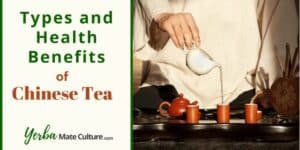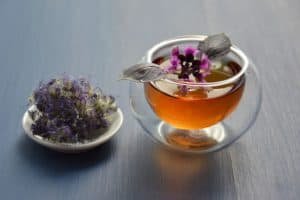In the whirlwind of motherhood, finding a moment of tranquility can sometimes seem like a distant dream. Tea, with its soothing warmth and gentle flavors, offers a simple yet profound way to cultivate calm amidst the chaos.
In this guide, I’ll introduce you to herbal teas known for their ability to ease stress, soothe nerves, and promote relaxation. Whether you’re looking for a quick pause in your day or a peaceful end to your evening, these tea recipes are more than just beverages — they’re a ritual for restoring balance and reclaiming peace.
So, take a deep breath, select your favorite mug, and prepare to immerse yourself in the comforting embrace of these stress-relieving brews.
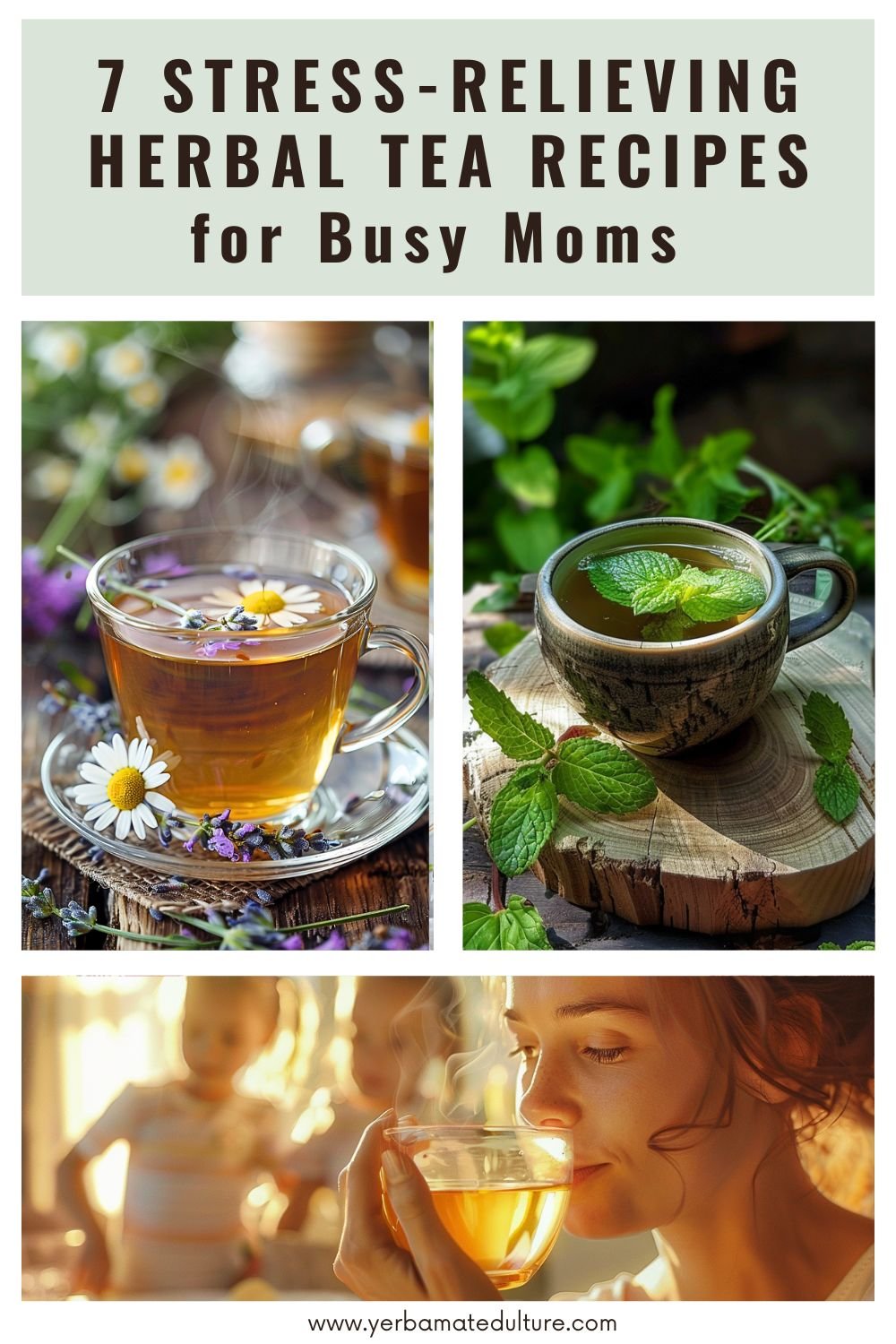
Chamomile Delight: A Classic Soother
Chamomile tea is popular worldwide for both its mild, sweet flavor and its remarkable ability to soothe the mind and body.
Known as a natural remedy for reducing anxiety and promoting better sleep, chamomile is a go-to choice for anyone needing to unwind and relax.
Health Benefits:
- Anxiety Reduction: Chamomile contains apigenin, an antioxidant that binds to certain receptors in the brain, which may help reduce anxiety and initiate sleep.
- Sleep Promotion: The gentle calming effects of chamomile can help improve sleep quality, making it easier to fall asleep and stay asleep through the night.
- Digestive Relief: Chamomile is also helpful in soothing the stomach and easing digestive discomfort, often exacerbated by stress.
Recipe for a Soothing Chamomile Lavender Infusion
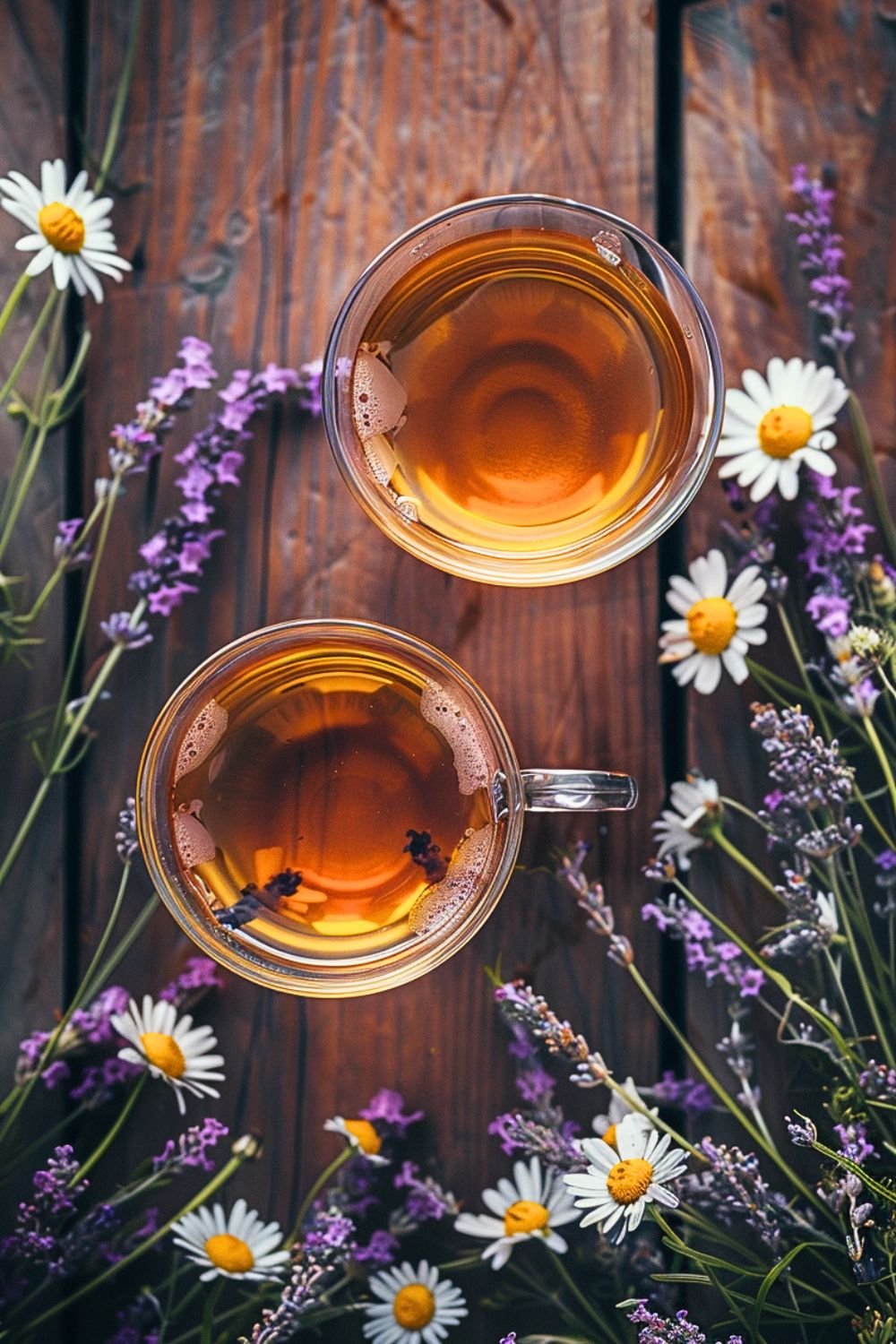
Ingredients:
- Dried chamomile flowers: 2 tablespoons
- Dried lavender flowers: 1 tablespoon
- Honey: 1 teaspoon (optional)
- Boiling water: 1 cup
Instructions:
- Prepare Your Ingredients: Measure out the chamomile and lavender flowers. Both of these can be found at health food stores or ordered from herbal suppliers online.
- Steeping the Tea: In a teapot or a heat-resistant glass container, combine the chamomile and lavender flowers. Pour one cup of boiling water over the flowers and cover the teapot or container. Let the tea steep for 5 to 10 minutes, depending on how strong you prefer the flavors. The longer it steeps, the more potent the calming effects.
- Straining and Serving: After steeping, strain the tea through a fine mesh sieve into a cup to remove the flower buds. This ensures a smooth drinking experience.
- Sweetening Your Tea: While chamomile and lavender both have naturally sweet and floral notes, adding a teaspoon of honey can enhance the flavors and add a touch of soothing sweetness.
- Enjoy: Sip this tea slowly, perhaps while sitting in a quiet spot where you can relax and enjoy a few moments of peace. The warmth and aroma of the tea, combined with the calming properties of chamomile and lavender, create a perfect backdrop for relaxation.
This Chamomile Lavender Infusion provides a therapeutic ritual that invites stillness into your day. By incorporating this tea into your routine, whether in the early morning hours before the day begins or in the evening as you wind down, you can help manage stress and cultivate a sense of calm.
Minty Freshness: Peppermint Tea
Peppermint tea is not only refreshing with its cool, invigorating flavor, but it’s also incredibly beneficial for busy moms needing a quick stress reliever.
The menthol in peppermint acts as a natural muscle relaxant and sedative, making it ideal for reducing mental stress and anxiety, as well as soothing digestive disturbances often brought on by hectic schedules.
Health Benefits:
- Stress and Anxiety Relief: The natural relaxing properties of menthol help to alleviate stress and promote relaxation of the mind and body.
- Digestive Health: Peppermint tea is excellent for soothing the stomach, relieving symptoms of bloating, and reducing abdominal pain due to its antispasmodic properties.
- Respiratory Benefits: Its menthol content can also help relieve nasal congestion and symptoms of colds, making breathing easier.
Let’s combine peppermint with our next ingredient, lemon balm, for a refreshing and relaxing combo.
Lemon Balm: The Nerve Soother
Lemon balm, a member of the mint family, is revered for its calming effects on the nervous system, making it an excellent choice for managing stress and anxiety.
Its light lemony flavor is both soothing and uplifting, perfect for a relaxing break in a busy mom’s day.
Health Benefits:
- Enhances Mood: Lemon balm has been found to improve mood and cognitive function, reducing anxiety and promoting a sense of calm.
- Sleep Support: It can also aid in sleep by acting as a mild sedative, helping to initiate a night of restful, uninterrupted sleep.
- Digestive Relief: Like peppermint, lemon balm serves as a digestive aid, easing symptoms of indigestion and nausea.
Recipe for Revitalizing Peppermint and Lemon Balm Tea
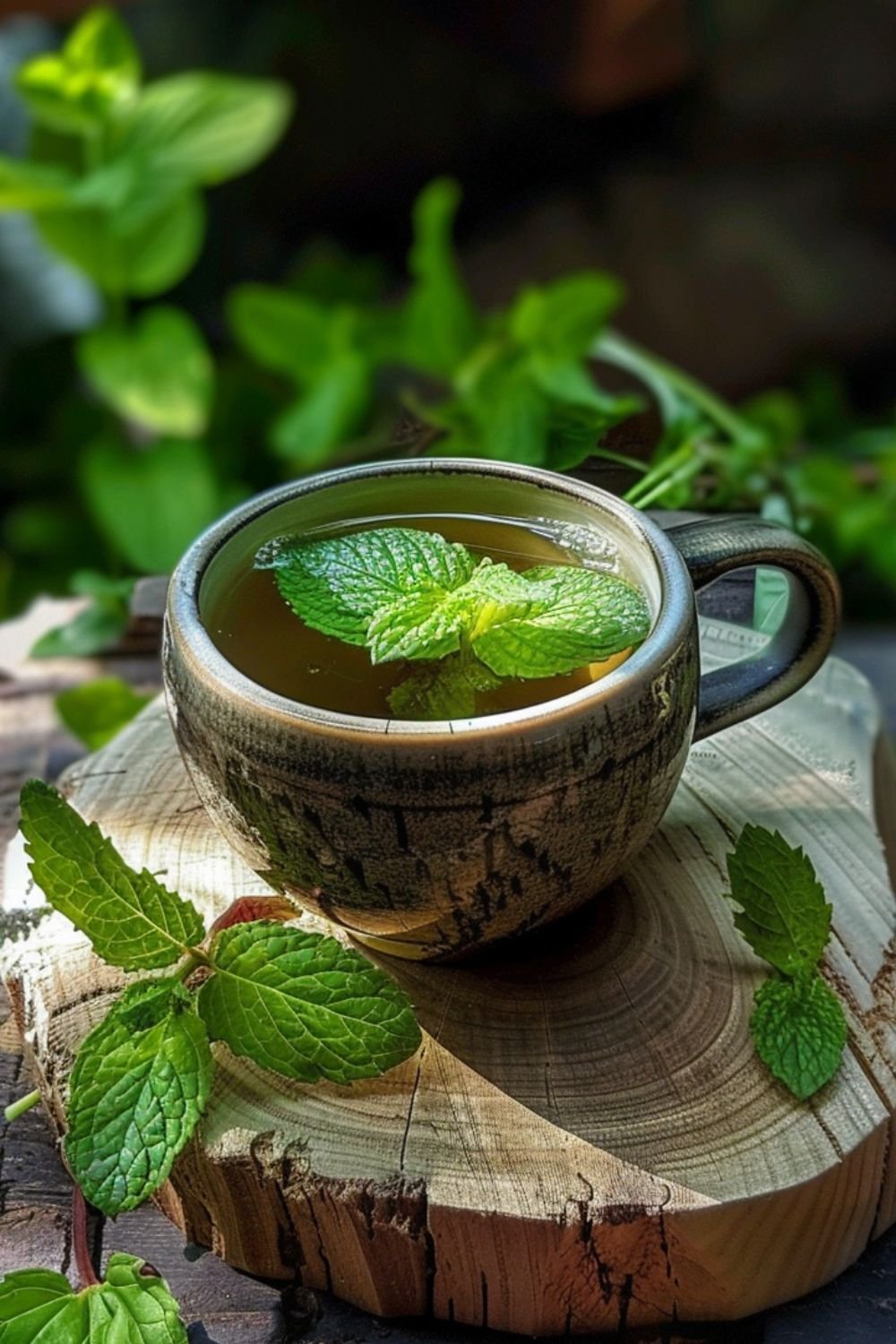
Ingredients:
- Fresh peppermint leaves: 1/4 cup (or 2 tablespoons dried)
- Fresh lemon balm leaves: 1/4 cup (or 2 tablespoons dried)
- Honey: 1 teaspoon (optional)
- Boiling water: 1 cup
Instructions:
- Prepare the Herbs: Gently bruise the peppermint and lemon balm leaves with your fingers to release their essential oils.
- Steeping: Place the bruised leaves in a teapot or a heat-resistant glass container. Pour boiling water over the leaves and cover to steep. Let the tea infuse for about 5-10 minutes.
- Straining: Use a fine mesh strainer to filter out the leaves as you pour the tea into a cup. This ensures a smooth texture and maximizes flavor extraction.
- Sweetening: Add a teaspoon of honey if you prefer a slightly sweet taste, which complements the natural flavors of the herbs.
- Enjoyment: Sip this tea when you need a moment of calm or after meals to aid digestion.
This Peppermint and Lemon Balm Tea blend offers a double dose of relaxation and digestive benefits, perfect for after a busy day or to enjoy during a peaceful moment alone.
Tulsi Tea: The Holy Basil Healer
Tulsi, or Holy Basil, is a revered herb in Ayurvedic medicine, known for its therapeutic properties that help balance the body’s stress response systems.
This herb is particularly effective for busy mothers who need to maintain a calm and composed demeanor throughout the day.
Health Benefits:
- Stress Reduction: Tulsi helps counteract the effects of stress-induced ulcers, lowers blood pressure, and reduces anxiety and depression.
- Immune Boosting: Regular consumption of tulsi tea can strengthen the immune system and help ward off infections, particularly beneficial for moms who need to stay healthy and active for their families.
- Balances Energy Levels: Tulsi has a unique combination of pharmacological actions that promote mental clarity and energy without overstimulation, helping you stay balanced and focused.
Recipe for Tulsi Tea with Ginger and Cardamom
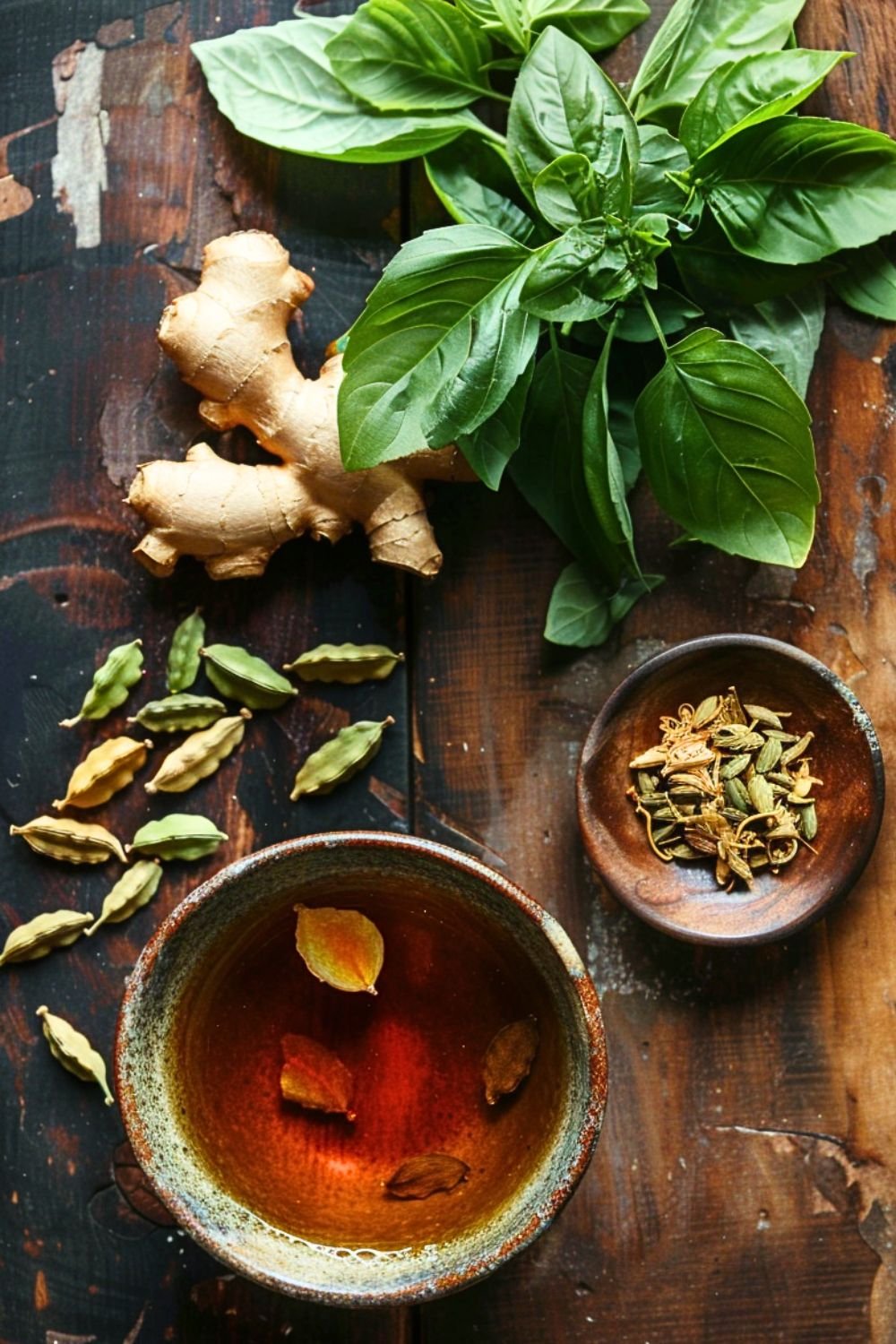
Ingredients:
- Tulsi leaves: 1 tablespoon dried or 1/4 cup fresh
- Fresh ginger root: 1 inch, thinly sliced
- Cardamom pods: 3, lightly crushed
- Honey: 1 teaspoon (optional)
- Water: 1 cup
Instructions:
- Prepare the Ingredients: Gather fresh tulsi leaves or measure out dried leaves. Prepare ginger by peeling and slicing.
- Brew the Tea: In a saucepan, bring water to a boil and add the tulsi leaves, ginger, and cardamom pods. Reduce heat and let simmer for about 5-10 minutes, depending on how strong you prefer the flavors.
- Strain and Serve: Strain the mixture into a cup, removing the leaves and spices.
- Sweeten: Add honey if desired and stir well
This medicinal remedy is designed to bring a profound sense of well-being, helping busy moms navigate their day with resilience and grace.
Valerian Root Nightcap
Valerian root, known for its potent sedative qualities, is the perfect herbal tea for busy moms who struggle to wind down and achieve restful sleep at night.
This herb has been used for centuries to promote tranquility and improve sleep quality, making it an ideal choice for those stressful days that need a peaceful ending.
Health Benefits:
- Promotes Sleep: Valerian root enhances the quality of sleep by reducing the time it takes to fall asleep and improving the depth of sleep, without the grogginess often associated with sleep aids.
- Reduces Anxiety: In addition to its sleep-inducing effects, valerian has been shown to calm anxiety by interacting with the brain’s GABA receptors, a mechanism similar to anxiety medications but without the dependency risks.
- Relieves Menstrual Symptoms: For women, valerian root can also help alleviate cramps and symptoms of PMS, which is beneficial for those particularly tough days.
Recipe for Valerian Root and Chamomile Bedtime Tea

Ingredients:
- Dried valerian root: 1 teaspoon
- Dried chamomile flowers: 1 teaspoon
- Boiling water: 1 cup
- Honey or lemon (optional, for flavor)
Instructions:
- Prepare the Brew: Combine the valerian root and chamomile flowers in a tea infuser or directly in a pot.
- Steeping: Pour boiling water over the herbs and cover; let them steep for 10-15 minutes. Covering the tea while steeping helps to trap the essential oils and flavors, maximizing the calming effects.
- Strain: Carefully strain the tea into your favorite cup to remove all the herbal residues.
- Enhance: If desired, add a spoonful of honey or a squeeze of lemon to enhance the tea’s flavor while adding a touch of soothing sweetness or a refreshing tang.
- Enjoy: Drink this tea about 30-60 minutes before bedtime to allow the herbs to work their magic for a peaceful night’s sleep.
Ashwagandha Warmth
Ashwagandha, often hailed in Ayurvedic medicine as a rejuvenator and general health tonic, is particularly effective in managing stress and enhancing overall vitality.
For busy moms, this adaptogenic herb can be a godsend, helping to balance the body’s response to physical and emotional stressors.
Health Benefits:
- Stress Relief: Ashwagandha is known for its adaptogenic properties, which help the body manage stress more effectively. It reduces cortisol levels and boosts brain function.
- Increases Energy and Stamina: Unlike stimulants that lead to crashes, ashwagandha supports sustained energy throughout the day, which is crucial for moms on the go.
- Boosts Immunity: Regular consumption can strengthen the immune system, which is essential for moms who need to stay healthy to care for their families.
Recipe for an Ashwagandha Spiced Tea

Ingredients:
- Ashwagandha powder: 1/2 teaspoon
- Cinnamon stick: 1
- Cardamom pods: 2, crushed
- Ginger slices: a few thin slices
- Milk (dairy or plant-based): 1 cup
- Water: 1 cup
- Honey (optional, for sweetness)
Instructions:
- Simmer the Spices: In a small saucepan, bring water to a boil and add the cinnamon, cardamom, and ginger. Let them simmer for about 5 minutes to extract the flavors.
- Add Ashwagandha: Stir in the ashwagandha powder and continue to simmer for another couple of minutes.
- Mix with Milk: Add milk to the saucepan and heat until warm but not boiling to avoid denaturing the milk.
- Sweeten and Serve: Remove from heat, strain into a cup, and stir in honey if using. Savor the warm, soothing effects of this herbal concoction.
Green Tea Serenity
Green tea is renowned for its subtle flavor profile and many health benefits, particularly its ability to enhance relaxation and mental clarity.
Health Benefits:
- Enhances Relaxation: Green tea contains the amino acid L-theanine, which has been shown to promote relaxation without drowsiness, helping to alleviate stress without compromising alertness.
- Boosts Brain Function: The combination of L-theanine and caffeine in green tea can improve brain function, leading to better concentration and sharper cognitive abilities, which are essential for multitasking.
- Rich in Antioxidants: The antioxidants in green tea, especially epigallocatechin gallate (EGCG), are effective in combating oxidative stress and inflammation, supporting overall health.
Recipe for Calming Citrus Green Tea Blend
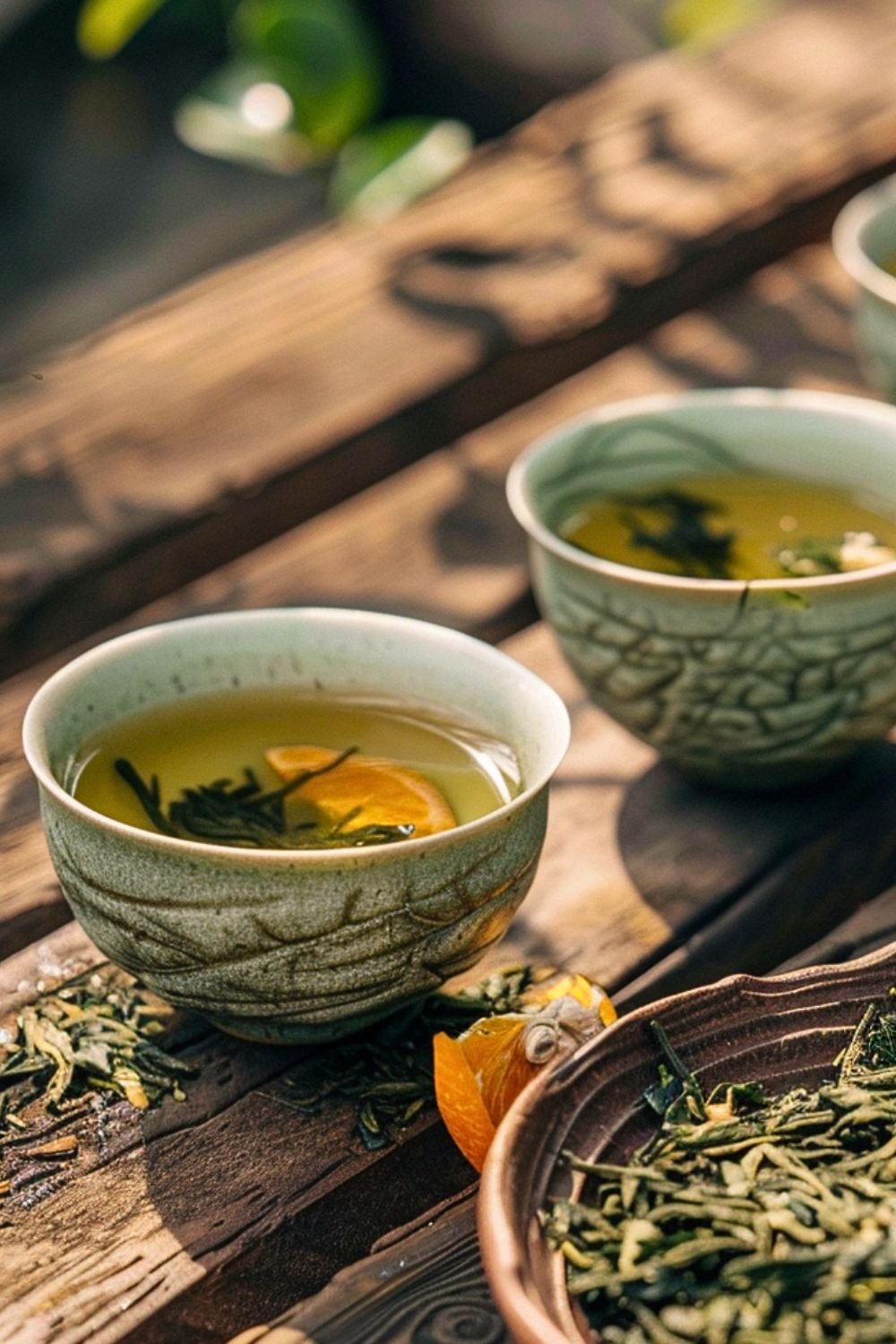
Ingredients:
- Green tea leaves: 1 teaspoon or 1 tea bag
- Fresh orange peel: 1 tablespoon
- Lemon juice: 1 tablespoon
- Honey: 1 teaspoon (optional)
- Boiling water: 1 cup
Instructions:
- Prepare Ingredients: Peel a small strip of orange peel and ensure there’s no white pith attached, as it can be bitter.
- Steeping: Place the green tea leaves and orange peel in a tea infuser or directly in a cup. Pour hot water (not boiling, ideally around 175°F to prevent bitterness) over the tea. Let it steep for 2-3 minutes.
- Enhance Flavors: Add lemon juice and honey to the steeped tea for a refreshing and soothing touch.
- Serve: Stir well, ensuring that the honey dissolves completely. Enjoy this aromatic and serene blend that provides a perfect pause in your busy day.
Herbal Harmony: Blending Your Own Stress-Relief Tea
Creating your own blend of herbal tea can be a deeply satisfying and therapeutic experience. By combining different herbs known for their calming properties, you can tailor a tea to your specific needs and preferences.
This chapter provides a guide for crafting a personalized tea blend that will help soothe the mind and spirit.
Creating Your Own Herbal Blend:
- Choose Your Base Herb: Begin by selecting a base herb that will form the foundation of your blend. For relaxation, chamomile, valerian root, or green tea are excellent choices due to their calming effect.
- Add Complementary Herbs: Incorporate one or two herbs that complement your base in flavor and enhance its effects. For a calming blend, consider adding lavender for its soothing properties or lemon balm for its ability to ease stress and anxiety.
- Consider a Dash of Flavor: Add herbs or spices that introduce an appealing flavor or a health boost to your tea. Mint can add freshness, cinnamon can provide warmth, and rose petals can offer a floral note and aesthetic appeal.
- Mixing Your Herbs: Use equal parts of each herb, or adjust according to taste and desired potency. Generally, a good starting point is to mix 1 teaspoon of each herb per cup of tea you plan to brew.
- Balancing the Blend: When mixing your herbs, consider both the flavors and how their health benefits complement each other. Ensure that no single herb overpowers the others unless it’s the desired dominant note of your blend.
Here is an example of a floral blend that I designed for a calming effect and a mild, pleasant taste:
Recipe for a Calming Blend of Lavender, Rose Petals, and Chamomile
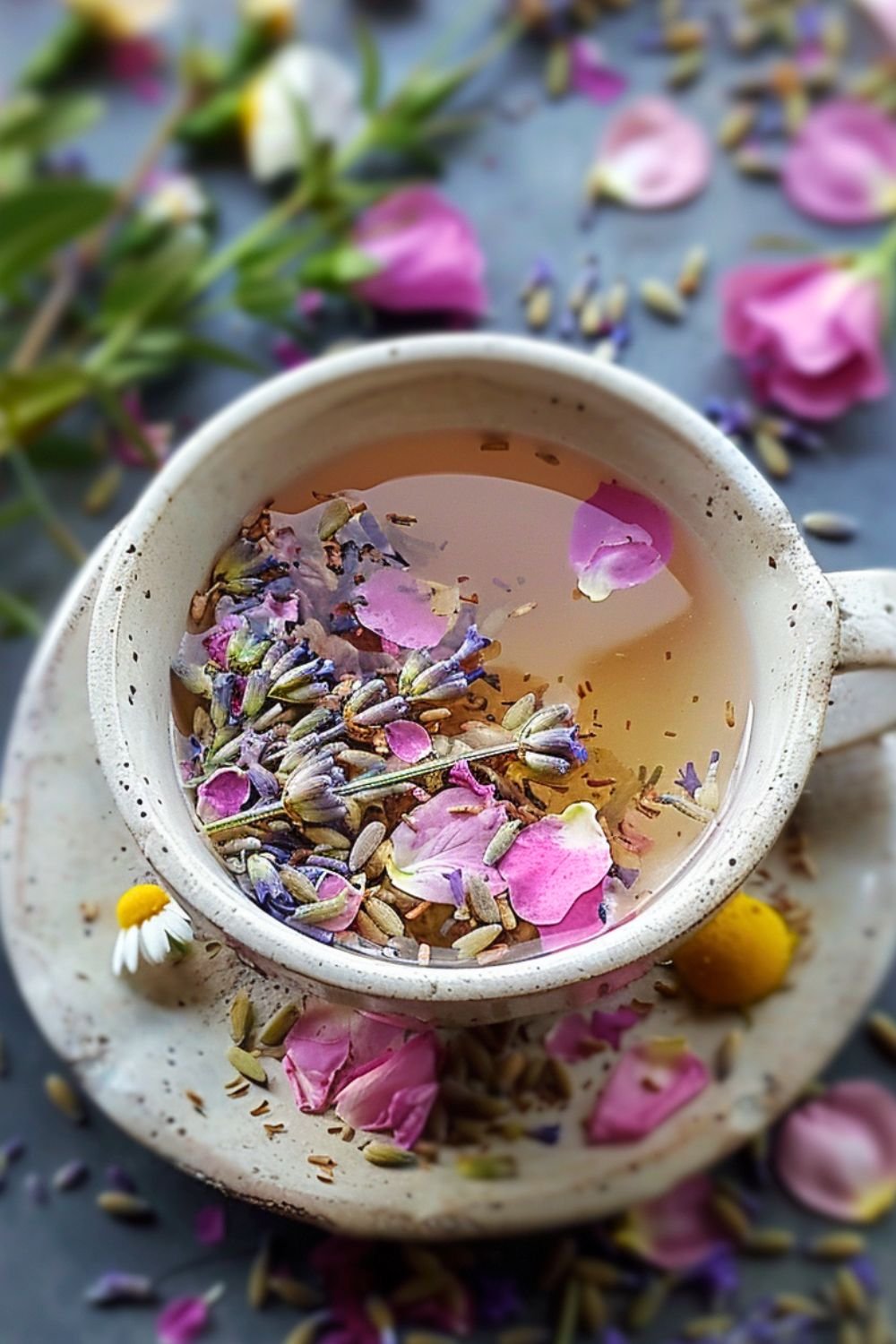
Ingredients:
- Dried lavender flowers: 1 teaspoon
- Dried rose petals: 1 teaspoon
- Dried chamomile flowers: 2 teaspoons
- Boiling water: 1 cup
Instructions:
- Mix the Herbs: In a small bowl, combine lavender, rose petals, and chamomile. Gently mix them to ensure an even distribution.
- Steep the Tea: Place the herbal mixture in a tea infuser or directly into a teapot. Pour boiling water over the herbs and cover to steep for 5-10 minutes, allowing the flavors and therapeutic properties to infuse the water.
- Strain and Serve: Strain the tea into your favorite mug, inhaling the aromatic steam as you do so. The act of breathing in the fragrance can begin the relaxation process even before your first sip.
- Enjoy: Sit back, relax, and enjoy the floral, soothing flavors of your homemade herbal tea.
Incorporating Tea Rituals into Your Day
For busy moms, finding small moments for self-care throughout the day can make a significant difference in managing stress and maintaining overall well-being.
Incorporating tea rituals into your daily routine can provide structured pauses, which are essential for mental and physical health.
Benefits:
- Structured Relaxation: Scheduled tea breaks encourage regular intervals of relaxation, which can help prevent the buildup of stress throughout the day.
- Mindfulness Practice: The ritual of preparing and enjoying tea can serve as a form of mindfulness, helping to center your thoughts and calm your mind.
- Sensory Engagement: The warmth of the tea, the aroma of the herbs, and the taste of the brew can stimulate the senses in a soothing way, providing a therapeutic experience.
Tips for Mindful Tea Drinking Practices:
- Create a Special Space: Designate a specific spot in your home for enjoying tea—a cozy corner, a sunny spot by the window, or even a quiet nook in your kitchen.
- Choose Your Time: Decide on the best times for tea breaks in your schedule. Perhaps a morning tea to start the day, a mid-afternoon break, or a calming brew before bedtime.
- Engage Your Senses: Pay attention to each step of the tea-making process. Notice the colors of the herbs, the smell of the steam, the warmth of the cup in your hands, and the flavors as you sip.
- Keep It Varied: Rotate your tea selections to keep the ritual exciting and beneficial. Different times of day or different moods might call for different types of tea.
By embedding these tea rituals into your daily life, you can enhance your ability to manage stress and enjoy moments of peace amidst the demands of motherhood.
Each cup of tea becomes a mini-retreat, a personal oasis of calm that renews and refreshes your spirit!


